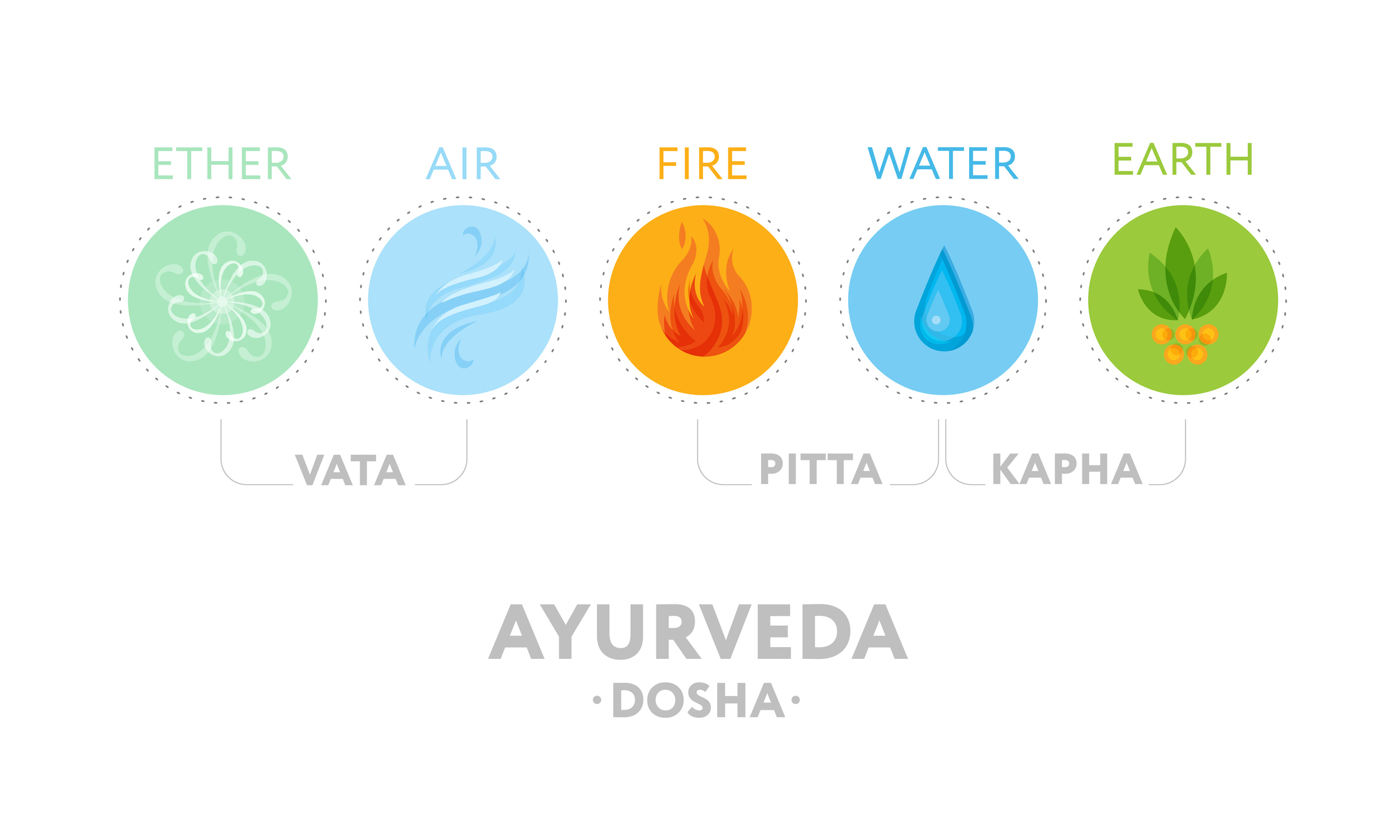Ayurveda ranks among the oldest holistic healing systems and continues to be widely practiced today. Integrating physical, mental, and spiritual wellness, Ayurveda emphasizes whole-person healing and proposes that an individual’s dosha is the active principle shaping their temperament and health.
Ayurvedic thinking is rooted in the belief that the universe consists of five elements — aakash (space), jala (water), prithvi (earth), teja (fire), and vayu (air).
Different mixes of these elements give rise to three humors, or doshas, called vata, kapha, and pitta. These doshas are thought to govern an individual’s physical, mental, and emotional functioning.
There is no conclusive scientific evidence supporting the actual existence of doshas.
Still, advocates of Ayurveda maintain that following dosha-tailored practices can restore balance and improve well-being.
Understanding Ayurveda and doshas
Each person is believed to possess a distinct proportion of the three doshas, often with one predominating. For instance, one individual might be primarily pitta while another is mainly vata. An Ayurvedic clinician can assist in identifying your dominant dosha.

That unique proportion of vata, kapha, and pitta constitutes a person’s Ayurvedic constitution, serving as a guide for achieving optimal wellness.
Although evidence validating doshas is sparse, many Ayurvedic supporters attribute this to a shortage of research and funding. Rather than dismissing the system, they call for more scientific inquiry to substantiate its benefits.
How each dosha presents
Drawing from centuries of practice, an Ayurvedic practitioner evaluates physical, emotional, mental, and behavioral signs to determine someone’s dosha. Below is a broad summary of each dosha.
Vata
Vata is primarily composed of the two elements air and space (ether) and is typically characterized as cold, light, dry, rough, mobile, and expansive. Autumn is associated with vata because of its cool, crisp atmosphere.
Individuals with a vata constitution are often slender, lively, and imaginative. They tend to think creatively but can be easily sidetracked. Additionally, their mood can fluctuate with changes in weather, social surroundings, and diet.
Ayurvedic guidance suggests vata-dominant people follow a predictable daily schedule, reduce stress through meditation and calming practices, and keep the body warm by avoiding cold exposure and favoring warm foods and beverages.
Kapha
Kapha (pronounced “kuffa”) arises from earth and water. It’s described as steady, stable, heavy, slow, cool, and soft. Spring is often linked to kapha as the world awakens from winter dormancy.
Those with a kapha constitution are portrayed as robust, solid-boned, and nurturing. They’re dependable, provide support to others, and typically remain calm, deliberate, and thoughtful in their actions.
To stay well, kapha-dominant individuals are advised to exercise regularly, follow a nutritious diet, keep warm (for example, using a sauna or consuming warm meals), and maintain consistent sleep patterns.
Pitta
Pitta, associated with fire and water, is linked to a driven temperament. It is commonly depicted as hot, light, sharp, oily, fluid, and dynamic. Summer is considered pitta season due to its warmth and sunshine.
Pitta-dominant people are often muscular, athletic, and natural leaders. They are focused, ambitious, and competitive. However, their intense nature can sometimes lead to interpersonal tension.
Those with a pitta constitution are encouraged to maintain work-life balance and avoid excessive heat, including hot climates and very spicy foods.
Dosha-based practices and the evidence
Although many people report personal success with Ayurvedic approaches, there’s limited scientific evidence connecting a balanced dosha with improved health.
Ayurvedic philosophy holds that “like attracts like” and that balancing opposites can restore harmony. For each dosha, specific dietary choices, exercises, and lifestyle habits are recommended to promote equilibrium.
Diet
While limited research exists, following an Ayurvedic diet tailored to one’s dosha is believed to help restore balance and support health.
DoshaFoods to eatFoods to avoid
Vata warm, moist, and soft items (e.g., berries, bananas, peaches, cooked vegetables, oats, brown rice, lean meats, eggs, dairy) bitter, dry, and cold items (e.g., raw veggies, chilled desserts, dried fruit, nuts, seeds)
Kapha spicy, pungent, and light foods (e.g., most fruits and vegetables, whole grains, eggs, low-fat cheese, unprocessed meats, hot spices) heavy, fatty foods (e.g., rich fats, fried and processed items, nuts, seeds)
Pitta cooling, light, sweet, and energizing foods (e.g., fruits, non-starchy vegetables, oats, eggs) heavy, hot, and sour foods (e.g., red meat, potatoes, hot spices)
When someone feels out of balance, Ayurveda recommends avoiding foods that mirror their predominant dosha. It’s also suggested that diet might shift with the seasons, such as favoring warm meals in colder months.
Although many adherents say an Ayurvedic diet makes them feel better, there’s no robust evidence showing it actually rebalances doshas or that digestive function fluctuates seasonally.
Many recommended foods—fruits, vegetables, whole grains, and minimally processed items—are generally healthful. Still, it’s wise to consult a healthcare professional before making major dietary changes.
Exercise
An Ayurvedic practitioner may recommend different forms of physical activity depending on your dosha:
- Vata. Given their restless energy, vata types benefit from activities involving steady movement, such as cycling, jogging, walking, yoga, or tai chi.
- Kapha. Kapha types thrive with a workout partner and do well with a mix of cardio and resistance training to remain engaged. Any regular activity helps this group.
- Pitta. Pitta types often overexert and should avoid exercising in excessive heat. Team sports and competitive activities can satisfy pitta’s drive while providing structure.
Most scientific attention in this area focuses on gentle practices like yoga, which have been linked to benefits including better quality of life, improved fitness, and stress reduction.
Although tailoring exercise to personality and sensitivities may be sensible, there’s no clear research proving that matching workouts to dosha is effective.
Lifestyle practices
Ayurveda promotes healing of body, mind, and emotions and encourages habits such as:
- yoga
- meditation
- mindful eating
- sleep hygiene
- time alone and social connection
- managing work-life balance
Maintaining a daily routine that includes these healthy practices is considered important in Ayurveda. A regular rhythm is believed to align you with the elements and support wellness.
While there is no evidence that lifestyle routines tailored to individual doshas produce superior outcomes, adopting these generally healthy practices is still recommended.
The takeaway
Ayurveda remains popular for its emphasis on whole-person healing.
From the Ayurvedic viewpoint, an imbalanced dosha leads to illness, so choosing foods, exercise, and daily routines based on your dosha is thought to restore balance and health.
Although many supporters assert that health depends on one’s dosha, scientific validation is limited.
Even with limited research on doshas, incorporating the wholesome lifestyle habits promoted by Ayurveda—balanced nutrition, regular exercise, stress management, and consistent routines—can be a positive way to support overall health.


















Leave a Reply
You must be logged in to post a comment.